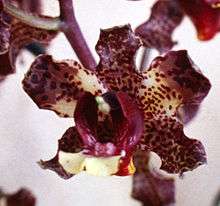Cyrtopodium
Cyrtopodium, often abbreviated Cyrt in horticulture, is a genus of more than 40 species of epiphytic and terrestrial orchids found from Florida and Mexico through Argentina.[1] Cyrtopodium is the only genus in the monotypic subtribe Cyrtopodiinae.[2]
| Cyrtopodium | |
|---|---|
 | |
| Cyrtopodium cristatum inflorescence with a caterpillar | |
| Scientific classification | |
| Kingdom: | Plantae |
| Clade: | Tracheophytes |
| Clade: | Angiosperms |
| Clade: | Monocots |
| Order: | Asparagales |
| Family: | Orchidaceae |
| Subfamily: | Epidendroideae |
| Tribe: | Cymbidieae |
| Subtribe: | Cyrtopodiinae Benth. |
| Genus: | Cyrtopodium R.Br. |
| Type species | |
| Cyrtopodium andersonii (Lamb. ex Andrews) R. Br. | |
| Synonyms[1] | |
|
Tylochilus Nees | |
The type species is C. andersonii, originally described in 1812 by A.B. Lambert as Cymbidium andersonii, and in 1813 used by Robert Brown to erect his new genus Cyrtopodium.[3]
List of species

Fruiting stand of Cyrtopodium andersonii

Cyrtopodium parviflorum flower

Cyrtopodium brunneum
- Cyrtopodium aliciae L.Linden & Rolfe
- Cyrtopodium andersonii (Lamb. ex Andrews) R.Br. in W.T.Aiton
- Cyrtopodium blanchetii Rchb.f.
- Cyrtopodium braemii L.C.Menezes
- Cyrtopodium brandonianum Barb.Rodr.
- Cyrtopodium brunneum J.A.N.Bat. & Bianch.
- Cyrtopodium cachimboense L.C.Menezes
- Cyrtopodium caiapoense L.C.Menezes
- Cyrtopodium cipoense L.C.Menezes
- Cyrtopodium confusum L.C.Menezes, 2008
- Cyrtopodium cristatum Lindl.
- Cyrtopodium dusenii Schltr.
- Cyrtopodium eugenii Rchb.f. & Warm. in H.G.Reichenbach
- Cyrtopodium flavum (Nees) Link & Otto ex Rchb.
- Cyrtopodium fowliei L.C.Menezes
- Cyrtopodium gigas (Vell.) Hoehne
- Cyrtopodium glutiniferum Raddi
- Cyrtopodium graniticum G.A.Romero & Carnevali
- Cyrtopodium hatschbachii Pabst
- Cyrtopodium holstii L.C.Menezes
- Cyrtopodium × intermedium Brade (C. gigas × C. glutiniferum)
- Cyrtopodium josephense Barb.Rodr.
- Cyrtopodium kleinii J.A.N.Bat. & Bianch.
- Cyrtopodium lamellaticallosum J.A.N.Bat. & Bianch.
- Cyrtopodium latifolium Bianch. & J.A.N.Bat.
- Cyrtopodium linearifolium J.A.N.Bat. & Bianch.
- Cyrtopodium lissochiloides Hoehne & Schltr.
- Cyrtopodium longibulbosum Dodson & G.A.Romero
- Cyrtopodium macedoi J.A.N.Bat. & Bianch.
- Cyrtopodium macrobulbum (Lex.) G.A.Romero & Carnevali
- Cyrtopodium minutum L.C.Menezes
- Cyrtopodium naiguatae Schltr.
- Cyrtopodium pallidum Rchb.f. & Warm. in H.G.Reichenbach
- Cyrtopodium palmifrons Rchb.f. & Warm. in H.G.Reichenbach
- Cyrtopodium paludicola Hoehne
- Cyrtopodium paniculatum (Ruiz & Pav.) Garay
- Cyrtopodium parviflorum Lindl.
- Cyrtopodium pflanzii Schltr.
- Cyrtopodium poecilum Rchb.f. & Warm. in H.G.Reichenbach
- Cyrtopodium punctatum (L.) Lindl.
- Cyrtopodium saintlegerianum Rchb.f.
- Cyrtopodium schargellii G.A.Romero, Aymard & Carnevali
- Cyrtopodium triste Rchb.f. & Warm. in H.G.Reichenbach
- Cyrtopodium vernum Rchb.f. & Warm. in H.G.Reichenbach
- Cyrtopodium virescens Rchb.f. & Warm. in H.G.Reichenbach
- Cyrtopodium willmorei Knowles & Westc.
- Cyrtopodium witeckii L.C.Menezes, 2009
- Cyrtopodium withneri L.C.Menezes
- Names brought to synonymy
- Cyrtopodium elegans, a synonym for Tetramicra canaliculata
gollark: The bottom one would need powering, though.
gollark: You could use RFTools elevators perhaps.
gollark: I was going to have single-track rail lines in my tunnels, actually.
gollark: My existing tunnels are 4x3 stone brick ones.
gollark: I favour the staircasey design.
References
- Kew World Checklist of Selected Plant Families
- Pridgeon, A.M., Cribb, P.J., Chase, M.A. & Rasmussen, F. eds. (2009). Genera Orchidacearum, Volume 5. Oxford Univ. Press.
- Brown, Robert, in Aiton, William Townsend. 1813. Hortus Kewensis; or, a Catalogue of the Plants Cultivated in the Royal Botanic Garden at Kew. London (2nd ed.) 5: 216.
External links
| Wikimedia Commons has media related to Cyrtopodium. |
| Wikispecies has information related to Cyrtopodium |
This article is issued from Wikipedia. The text is licensed under Creative Commons - Attribution - Sharealike. Additional terms may apply for the media files.